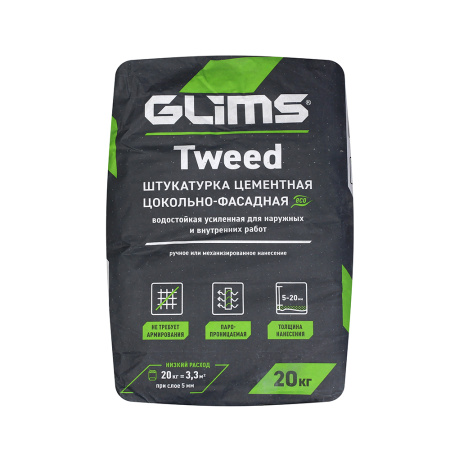Plaster for restoration work, reconstruction of buildings and structures. It is applied on concrete, brick lower stratums and cement-based plasters. For exterior and interior use.
ADVANTAGES
- Extra-strong
- Perfect for facing facades and pedestals
- Becomes even easily and does not form shrinkage cracks
- High adhesion
- Vapor permeable
- Compatible with all coating materials
- For manual and mechanical application
- Complies with European standards EN 998-1 Class CSIIW2
- Cost-efficient, longeval
- Does not require finish filling
ADVANTAGES
It is applied on concrete, stone, brick, cement-based plasters. The lower stratum surface must be dry, durable, free from dust, dirt, paint and grease stains. it is necessary to treat the cleared surface with GLIMS® PrimeГрунт. Work surfaces on the windward side should be protected from rain. In sunny and very warm weather cover the applied plaster with tarpaulin, film or netting until its drying-out. When applying and hardening the finishing mortar the temperature of the lower stratum and the environment should not be lower than +5 ° C.
MORTAR PREPARATION
Manual method. Pour the dry mix into a reservoir with clean water at a rate of 0.25 l of water per 1 kg of dry mix (5 l per bag of 20 kg) and mix thoroughly with a mixer machine to even consistency. The mortar is in working order for 1,5-2 hours after mixing. If during this time the mortar thickens in the reservoir, it is necessary to “revive” it by mixing without adding of water. The mechanical method. Pour the dry mix into the receiving hopper of the mortar mixing pump. Adjust the water flow in accordance with the required mortar mix consistency.
SURFACE PLASTERING
The mortar is recommended to be applied in three stages: the primer layer is applied 2-3 mm thick with a more liquid mortar (0.26 - 0.27 l of water per 1 kg), the mortar is not smoothed; after it has set (after 3-4 hours), the main layer is applied with a mortar of normal density (0.25 l of water per 1 kg) to the required thickness, but not more than 15 mm in one operation. If it is required to apply a thicker layer, then layer-by-layer application with intermediate drying is recommended for at least 24 hours. The applied mortar mix is leveled by the aluminum screed bar (h-profile). After 1 hour, the surplus material is removed by the trapezoidal screed bar. If joint displacement indicator bars were used, it is recommended to remove them and level the recessions with GLIMS®Tweed plaster. After the mortar setting (12 hours), a finishing coat is applied and troweled with plastic floats.
CONSUMPTION: 1,2 kg/m2 per 1 mm of layer thickness.
PACKAGING: Kraft paper bags 20 kg (net); prepackaging of 5 kg in plastic bags.
TRANSPORTATION AND STORAGE
During transportation and storage, bags with dry mortar should be protected from damage and soaking. The storage period is 12 months. TU5745-010-40397319-2003№0370/3

